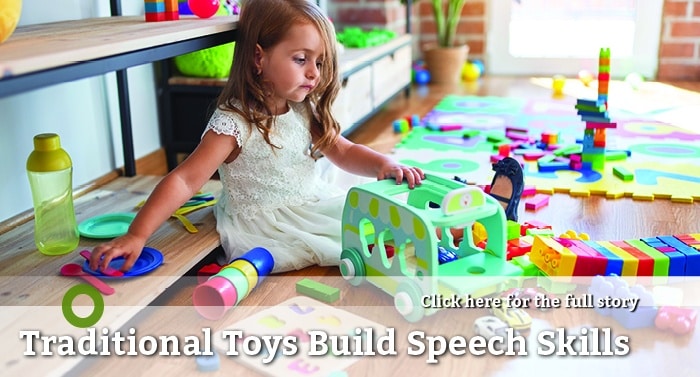By Anna Sosa, PhD, CCC-SLP
Now, more than ever, parents have an endless array of options when it comes to buying toys for their little ones. Whether it’s a Laugh & Learn Crawl-After Cat On a Vac or a Jurassic World Super Colossal Giganotosaurus, many parents feel the pressure to bring home the latest cool toys. In an effort to provide the “best” or most “educational” playthings, it’s easy to overlook what kiddos really need.
Children learn to communicate from the moment they are born with non-verbal cues like crying and smiling. This skill continues to grow exponentially through their toddler years as they learn to speak and express themselves through words. The first three years of life is especially important for speech and language development. By six months old, babies recognize sounds from their primary language. Around that age, they’ll probably begin babbling. And when they approach their first birthday, they’re likely to recognize common words and respond to basic requests, like “come here” and start to say some words.
So, what sorts of toys should parents prioritize during this transformative time?
Research in the areas of play and speech and language development suggest there’s a clear choice. While it’s tempting to reach for the flashy electronic items, traditional toys are best. And that’s because these are the kinds of toys that get the conversation going and keep it going! These toys encourage caregivers to talk more and to be more responsive in their interactions with their young children. These would include:
- Blocks
- Shape sorters
- Chunky puzzles
- Stacking cups
- Building toys, like Lincoln Logs
- Structural toys, like Tinker Toys
- Symbolic toys, like kitchen or tool sets
Children’s brains are growing quickly in the early years. In the first year alone, a baby’s brain doubles in size. They’re listening to everything they hear, and it impacts how their brain develops. In fact, hearing a wide variety of words every day is one of the biggest determinants of success for future literacy.
More traditional toys work to grow language skills because they create opportunities for high quality verbal interactions between parent and child. Especially in the early years, these interactions build a strong foundation for enhanced language skills.
The electronic toys that are so popular today can cause caregivers to disengage, meaning kids don’t hear as many words as those who have more interactive play. Of course, that doesn’t mean parents need to toss out or forgo all electronic toys, but they’re better for entertainment than education.
When babies play with electronic toys, parents are less likely to speak with them, and when they do, they use fewer “content specific” words, leaving kids with less exposure to words about animals, shapes, colors and more. In every minute of play, parents use more than double the number of words than during play with electronic toys. Children speak more, parents respond nearly twice as much, and the little ones benefit over the long term.
And don’t forget about books. Books provide a great opportunity for language development through rhyming, repetition and learning new words. But if your small child won’t sit still long enough to engage with an age-appropriate book, there’s no need to fret; traditional toys can offer the same learning benefits when they are coupled with caregiver engagement.
To boost a child’s language development, prioritize toys that engage both child and parent, rather than ones that simply offer lights, sounds or a simple distraction. This early investment can even lead into improved academic success.
Anna Sosa, PhD, CCC-SLP, is the department chair and professor at Northern Arizona University. She is also Director of NAU’s Child Speech and Language Lab. Dr. Sosa completed her PhD in Speech and Hearing Sciences at the University of Washington. She has also worked as a school-based Speech Language Pathologist in Washington State.

